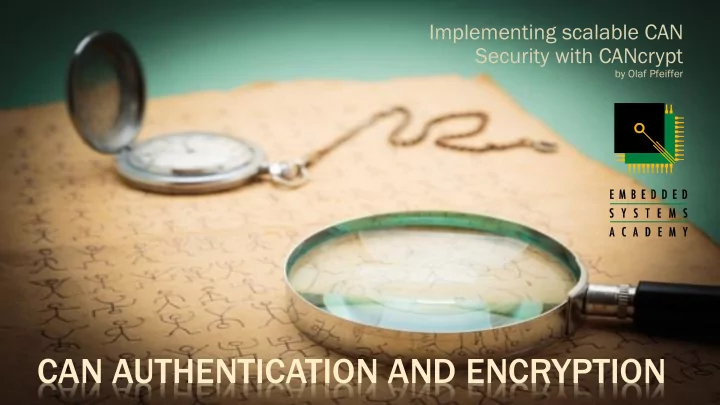

Implementing scalable CAN Security with CANcrypt by Olaf Pfeiffer CAN AUTHENTICATION AND ENCRYPTION
February 2017 CAN PROVIDES MULTIPLE ATTACK VECTORS Record and re-play messages Can trigger desired actions Re-engineering Monitor and analyse Inject messages Denial-Of-Service (DOS) attack Generate selected commands CANcrypt
February 2017 CHALLENGES OF CAN SECURITY Small message size Popular security methods Single byte command Require a minimum of 128bit block sizes, Sometimes „known“ data preferably larger Limited resources Can not easily (real-time, Microcontrollers with witin microseconds) be limitations on code and RAM handled by microcontrollers size without on-chip security Can security be added to existing communication? CANcrypt
February 2017 CANcrypt base functions and protocols ″KEY″ ELEMENTS CANcrypt
February 2017 CANCRYPT SOFTWARE FRAMEWORK Customizable security Grouping functions Based on inital shared key Simple bit mixup for lower Permanent or last sessison performance microcontroller Secure heartbeat Updates shared dynamic key Key Management Pairing Key Hierarchy Based on inital shared key Secure key transfers From a key hierarchy Slow but invisible CAN Updated shared dynamic key communication By invisible shared bit generation Shared bit generation CANcrypt
February 2017 CANCRYPT‘S KEY HIERARCHY CANcrypt is based on shared symmetric keys Configurable length Multiple keys per device provide a key hierarchy Key can be combined with serial number CANcrypt
DYNAMIC KEY To prohibit record and replay attacks Key must cyclically change Key must be synchronized Key update based on Shared random values Permanent key Counters and or data CANcrypt
February 2017 ONE-TME PAD SECURITY LEVEL If a random key is as big as the data encrypted and the key is only used once, then a simple XOR provides strongest encryption / security level CANcrypt
February 2017 CANCRYPT‘S ONE TIME PAD How close can we get to a “true” one -time pad? Or: how close do we need to get to a “true” one -time pad? Highest level not required Here: based on dynamic key with input from Permanent key CANcrypt Message counter Optional: last data
February 2017 Monitoring, grouping and secure heartbeats MINIMAL EFFORT AUTHENTICATION CANcrypt
February 2017 MINIMAL PRECAUTIONS All devices must monitor network for injected / unexpected messages Look for CAN IDs used for transmission Produce an alert / emergency if such a message is detected NOTE: this is already done by CiA 447 profile devices CANcrypt
February 2017 SECURE HEARTBEAT GENERATION Uses dynamic one-time pad Consists of 3 random bytes 1 byte checksum Initializer from one-time pad All 4 bytes XOR encrypted using one-time pad CANcrypt
February 2017 SECURE HEARTBEAT CONSUMER Consumer decrypts the 4 bytes of secure heartbeat Calculates the checksum On match, continue All random bytes are used by all participants to re-generate one-time pad CANcrypt
February 2017 GROUPING AND HEARTBEAT PROTOCOLS Initial pairing requests include information about which key from hierarchy to use as a base Participants synchronize themselves with the grouping / heartbeat cycles CANcrypt
February 2017 SO FAR: AUTHENTICATED COMMUNICATION All producers All consumers Monitor network for On receive of messages unexpected messages handle them as not yet authenticated On detection Authenticated by next Send alert secure heartbeat cycle Else Depending on driver Send secure heartbeat implementation and FIFOs one extra cycle might be CANcrypt required
February 2017 Pairing and secure messaging SECURITY FOR PAIRED DEVICES CANcrypt
February 2017 CAN SPECIFIC SECURITY: PAIRING If 2 nodes randomly select a Exception: CAN ID to transmit unless observer has signal level access Example: range 10h to 1Fh No data advanced attack scenario and transmit these The 2 nodes know who synchronized, sent what and can derive 1 then an observer does not bit from this information know who transmitted which message CANcrypt
February 2017 GENERATE A SECRET RANDOM BIT IF I am the configurator device IF I transmitted lower bit generation message common bit is 0 ELSE IF I transmitted higher bit generation message common bit is 1 ELSE both used same message, no bit determined ELSE I am a device IF I transmitted lower bit generation message common bit is 1 ELSE IF I transmitted higher bit generation message common bit is 0 ELSE both used same message, no bit determined CANcrypt
February 2017 PERFECT ONE-TIME PAD IS POSSIBLE The 2 pairing nodes need a Performance not suitable “good” random number for larger data blocks generator But good enough to Shared permanent key used securely transfer keys to selectively flip bits 128 bit key, about 1.6s Ensures authentication, 256 bit key, about 3.2s shared bits are only identical if both have the same permanent key CANcrypt
February 2017 SECURE MESSAGING One-time pad security Two messages Unused bytes filled with random data Ensures size of 128 bit AES or other can be used 16 bit checksum CANcrypt
Grouping Implementing scalable CAN Security with CANcrypt Authentication by secure heartbeat Pairing Secure messaging between two devices Configuration, key transfers Key management Key hierarchy Customizable security functions SUMMARY www.esacademy.com/cancrypt
Recommend
More recommend